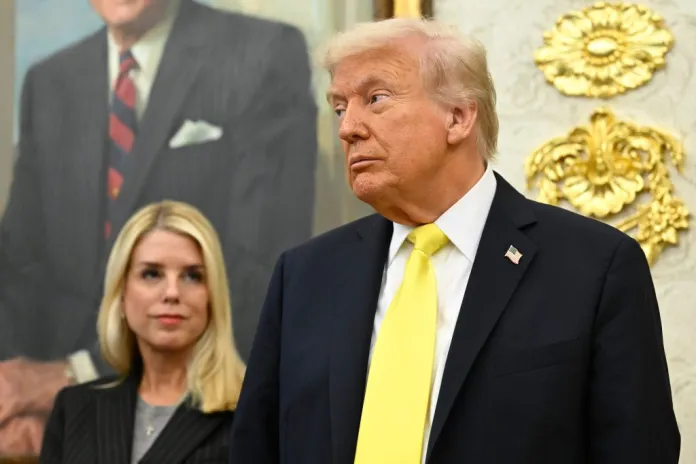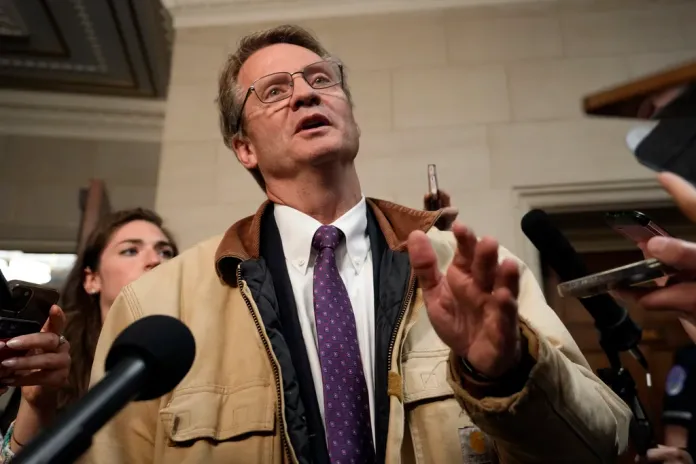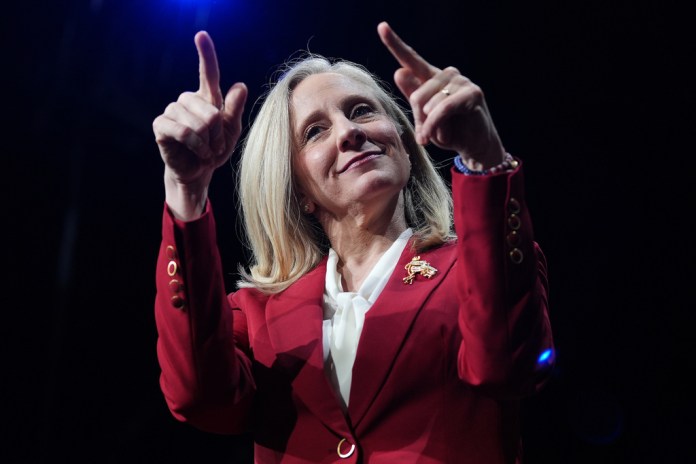Why voters are rejecting Bidenomics – Washington Examiner
Ims credit for the stock market’s growth and the low unemployment rate while ignoring the persistent inflation crisis that has eroded the purchasing power of American families. His policies have exacerbated inflation by flooding the economy with trillions of dollars in government spending, further driving up prices and squeezing households. As the cost of living continues to rise, it is clear that the Biden administration’s economic strategy is failing to address the root causes of inflation and provide relief to struggling Americans.
Why voters are rejecting Bidenomics
Heading into a bruising reelection fight, President Joe Biden faces an abysmal 38% approval rating on the economy. Yet the White House and much of the media blame the voters for failing to understand how good they’ve had it since 2021, with pundits and cable TV hosts trying to solve the mystery of how voters could possibly be so displeased with soaring prices, spiraling interest rates, massive budget deficits, and stagnant wages. Biden correctly reminds voters that he inherited a difficult economy. However, his aggressive spending and regulations proceeded to drive inflation, interest rates, and federal debt even higher than necessary.
The economic tone of this administration was set in its first 50 days with the enactment of the $1.9 trillion American Rescue Plan. Any voters still holding out hope that a Biden White House would be moderate, prudent, bipartisan, deficit-focused, or even willing to listen to economists instead witnessed the establishment of a highly political, partisan, and quite ideologically progressive administration.
The new administration began crafting the American Rescue Plan before the ink had even dried on a $900 billion stimulus law signed by former President Donald Trump weeks earlier. With this federal spending flooding an economy that was already beginning to recover and reopen from the pandemic, the Congressional Budget Office forecast that the 2021 economy would perform just $420 billion short of its $22 trillion capacity. However, the over-caffeinated White House responded by shooting a $1.9 trillion American Rescue Plan bazooka at this $420 billion output gap. This swollen package of bailouts, giveaways, and pent-up Democratic wish lists included $350 billion to bail out state budget deficits that did not actually exist, a bloated union pension bailout, and a decade’s worth of additional federal school funding. The White House then bought broader public support with child tax credits, unemployment insurance bonuses, and yet another round of taxpayer rebates.
Economists across the spectrum, including prominent Democrats Larry Summers and Jason Furman, warned that the American Rescue Plan was a massive overreach whose steep cost would trigger inflation, with Furman adding, “I don’t know any economist that was recommending something the size of what was done.” Unfortunately, the White House ignored the economists. Democrats had built a (false) narrative claiming that the slow recovery from the earlier Great Recession had been driven by insufficient federal spending, and the White House was committed not to repeat that “mistake.”
However, even these economic policy arguments took a back seat to raw politics. Democrats refused to negotiate or compromise even one inch with Republicans because they treated this Christmas tree bill as their reward for sweeping the 2020 election and their turn to match the GOP tax cuts with their own budget buster — although Republicans at least spread the cost of the 2017 tax cuts over a decade, while most of the American Rescue Plan’s exorbitant cost would be packed into a single year.
And so, on the 50th day of his presidency, Biden signed into law the American Rescue Plan — the most expensive spending bill in decades. As predicted, most of this spending ended up totally unnecessary, agencies and governors had no idea how to spend all of it, and inflation spiked exactly as warned, reaching 9.1%.
This persistent inflation has become the albatross weighing down Biden’s economic agenda. The president’s defenders correctly note that some modest degree of inflation was inevitable due to the earlier pandemic spending hiking demand in an economy in which supply, constrained by business shutdowns and supply chain breakdowns, simply could not keep up. But this is precisely why economists warned it would be economic malpractice to add another $1.9 trillion in federal spending that the economy could not absorb. According to the Federal Reserve Bank of San Francisco, the president’s actions added 3 percentage points to the inflation rate.
Even as inflation soared to 1970s rates, the Biden administration refused to take responsibility. At first, the White House dismissed inflation as “transitory,” and then it became a punch line for releasing a video bragging that “the cost of a Fourth of July cookout in 2021 is down $0.16 from last year.” When inflation became too persistent to dismiss, the White House shifted to scapegoating. It blamed COVID-19 and then “big meat” and then termed it “Putin’s price hike.” Biden even blamed 2021 inflation on a Russia-Ukraine war that did not begin until 2022. He claimed that spending trillions more through “Build Back Better” would somehow reduce inflation. Finally, over the objections of the White House’s own economists, Biden settled on blaming corporate greed for inflation. Of course, corporations have always been profit-maximizing, and the president never explained how such behavior suddenly became inflationary beginning in 2021. While the White House cycled through various scapegoats, prices rose a total of 20%, costing families more than $10,000.
In other words, the White House treated inflation as a communications challenge to message with talking points rather than an economic problem to solve with disinflationary policies. Even after declaring that “I have made tackling inflation my top economic priority,” Biden continued sacrificing inflation reduction at the altar of higher liberal goals. He enacted trillions more in inflationary spending hikes. He attempted a $400 billion student loan bailout that was mercifully shot down by the Supreme Court. Unions were given inflationary tariffs, “Buy American” rules, and Davis-Bacon prevailing wage mandates. Regulations raising the cost of economic development were tightened. Even a semiconductor bill that was supposed to reduce production costs instead hit producers with expensive child care and wage mandates that raised costs and prices. By the time Biden unveiled a $2.3 trillion Build Back Better proposal, even congressional Democrats had seen enough and dramatically scaled it back.
Unfortunately, the damage has been done. Once inflation begins, it is extremely difficult to stop because businesses continue to raise prices and wages in anticipation of inflation continuing. Even rising worker compensation has not kept up with rising prices since Biden took office. Those on fixed incomes have been hit the hardest.
The harder the president pushes the inflationary gas pedal with spending and regulations, the harder the Fed must slam the brakes with higher interest rates. The result has been mortgage rates leaping past 7% at the same time that home prices have surged. Accordingly, the monthly mortgage on a newly purchased median-priced home has doubled, from $1,109 to $2,235, since Biden took office. And like the proverbial demand for “more cowbell,” the president’s solution to inflation has been even more inflation, responding to these soaring house prices by proposing a $10,000 tax credit for homebuyers that would only push up demand and housing prices even further.
Consequently, America’s stubborn inflation rate remains near the top of Western developed countries in 2024. And as prices climb, the public’s mortgage, auto, and credit card debt and delinquencies, which temporarily declined due to large pandemic stimulus payments, are once again climbing.
Not all economic news is bad. After a sluggish start, the S&P 500 is up 43% over the president’s 3 1/2 years in office. Lower earners have seen larger wage gains than high earners. The economy, while sluggish, has managed to avoid falling back into recession. The unemployment rate has fallen back to below 4%, matching the impressive pre-pandemic levels.
Not surprisingly, the White House has wildly exaggerated its role in this good news. The president claims to have personally created 13 million jobs since he took office and describes himself as the most accomplished job creator in history. Such boasting not only ignores that the private economy, not politicians, creates the vast majority of jobs, but it also ignores that most of this recent job growth resulted simply from the economy reopening after the pandemic. Closing the economy, reopening it, and then taking credit for people returning to employment is akin to turning the lights off, then back on, and then claiming to have invented electricity.
Moreover, the quickly falling unemployment rate, while impressive, was also driven by the inflationary overheating of the economy. One cannot take credit for the faster job growth without also owning the painful inflation that those same policies brought.
And while inflation has been dreadful, Biden’s most lasting economic legacy may be his historic spending and debt binge. Trump had already signed legislation that cumulatively added a modern record of $7.8 trillion to 10-year deficits, only half of which was pandemic-related. Apparently inspired by his predecessor, Biden’s first 20 months saw him sign, or mandate through executive order, $4.8 trillion in new 10-year costs, including the aforementioned American Rescue Plan and enormous student loan bailouts.
The spending spree was finally stopped when lawmakers and voters screamed “enough!” First, the backlash to surging inflation led even Democratic lawmakers to kill the president’s $2.3 trillion Build Back Better proposal. Then, voters elected a Republican House to take away the president’s credit card.
Despite all of this spending and debt, Biden absurdly claims to have reduced budget deficits. After temporary pandemic spending spiked the budget deficit from $1 trillion in 2019 to $3 trillion in 2020 and 2021, the president points to the scheduled expiration of that spending in 2022 as a historic spending cut. Essentially, the president drastically spiked spending in 2021 with the American Rescue Plan and then treated the subsequent expiration of his own spending spree as a historic spending cut. This gaslighting was rebuked by even the fact-checkers at the Washington Post with a rare “Bottomless Pinocchio” rating.
The president’s true fiscal record is more dire. The CBO-projected budget deficit over the 2021-31 period has leaped by $5 trillion since Biden took office. Last year, the budget deficit, excluding the canceled student loan bailout, doubled from $1 trillion to $2 trillion — an unheard-of $1 trillion deficit surge for a growing economy in peacetime. At 7.5% of gross domestic product, last year saw the largest budget deficit in American history outside of temporary emergencies such as wars and recessions. Interest costs alone have jumped from $352 billion in 2021 to nearly $1 trillion this year and are projected to approach $2 trillion annually within a decade.
Biden has not only pushed this borrowing spree, but he also stubbornly opposes attempts to rein in deficits. Even as projected Social Security and Medicare shortfalls leap from $650 billion this year to $2.2 trillion a decade from now, driving nearly all of the projected escalating budget deficits, Biden pledges to block all serious reforms to rein in these costs or even avert Social Security’s scheduled trust fund insolvency within a decade — unfortunately, Trump shares his bipartisan position. Biden’s budget proposes a massive $5 trillion in new taxes over the decade, but nearly all of these revenues would be plowed back into new policies rather than deficit reduction, thus making future deficit reduction more difficult by having to start from an even higher tax level.
CLICK HERE TO READ MORE FROM THE WASHINGTON EXAMINER
Biden also tries to have it all ways on the extension of the expiring 2017 tax cuts. He pledges that Trump’s “tax cut is going to expire” and even assumes all such tax increase revenue in his budget — while also contradictorily promising not to let any taxes rise above today’s levels for the bottom 95% of earners.
Voters cannot be blamed for noticing these escalating prices, soaring budget deficits, elevating interest rates, and special interest giveaways. Overreaching on the American Rescue Plan and then relentlessly pursuing inflationary spending, regulation, and trade restrictions may cost Biden reelection in the same manner that inflation and overall incompetence doomed the earlier presidency of Jimmy Carter. Voters not only refused to reelect Carter, but such inflation and interest rates scarred a generation and induced four decades of Fed inflation hawkishness. If Biden shares Carter’s electoral fate, his flawed economic stewardship should serve as a lesson to future political leaders.
Brian Riedl is a senior fellow at the Manhattan Institute. Follow him on X: @Brian_Riedl.
" Conservative News Daily does not always share or support the views and opinions expressed here; they are just those of the writer."




